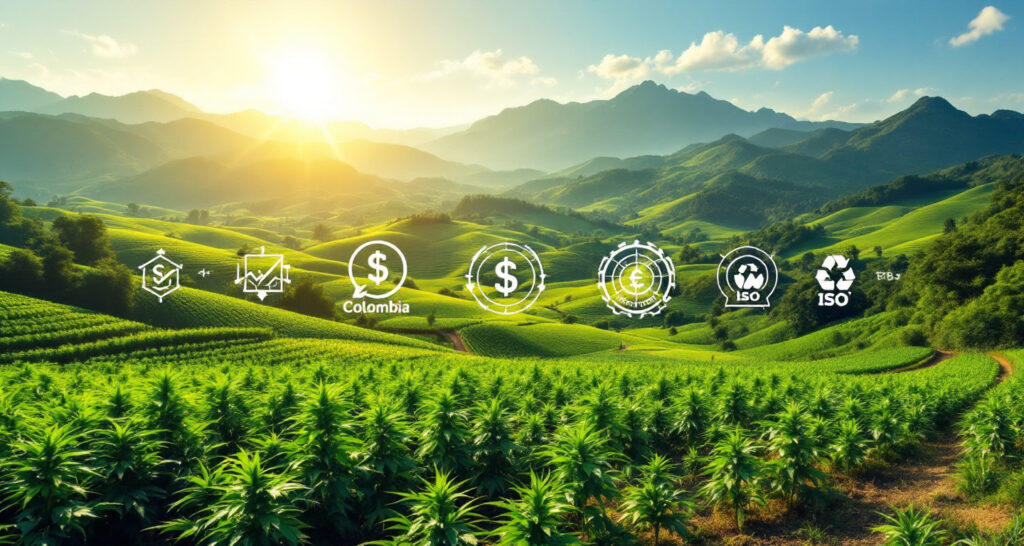Introduction: Colombia’s Green Revolution
Picture this: endless rows of vibrant cannabis plants basking in perfect equatorial sunshine, tended by skilled farmers whose agricultural expertise spans generations, all set against the backdrop of the majestic Andes mountains. This isn’t a scene from a cannabis enthusiast’s daydream—it’s the everyday reality of Colombia’s booming medicinal cannabis industry.
Colombia has quietly but confidently emerged as a global powerhouse in medicinal cannabis production. While Canada and the Netherlands grabbed early headlines in the global cannabis market, Colombia has been methodically building a production ecosystem that combines natural advantages, regulatory innovation, and sustainable practices that are increasingly difficult for global competitors to match.
The numbers tell a compelling story: production costs as low as 6 cents per gram (compared to $1-2 in North America), up to four harvests annually (versus one or two in seasonal climates), and export growth that nearly doubled in 2023 alone. These aren’t just impressive statistics—they represent a fundamental shift in how medicinal cannabis can be produced at scale while maintaining pharmaceutical-grade quality.
As global markets increasingly open to medicinal cannabis, Colombia’s unique combination of advantages is positioning the country not just as a supplier but as a true innovator in the space. Let’s explore why Colombian dry flower cannabis is revolutionizing global medical markets and what this means for buyers, pharmacies, licensed distributors, and executives in the B2B cannabis ecosystem.
Ideal Growing Conditions: Nature’s Perfect Cannabis Greenhouse
Perfect Climate for Cannabis Cultivation
If you were to design the ideal environment for growing cannabis from scratch, you’d essentially end up recreating Colombia’s natural conditions. Located near the equator, Colombia offers something that indoor growers spend millions trying to replicate: a perfect 12-hour photoperiod year-round. This consistent light cycle is cannabis cultivation equivalent of striking gold.
«Mother Nature has already optimized parts of Colombia for cannabis cultivation,» explains Andres Perez, CEO of Legendary-Seeds, a leading Colombian producer. «While indoor growers in Canada or Germany spend fortunes on lighting, climate control, and energy, we simply work with what nature provides.»
The stable temperatures in Colombia’s cannabis-growing regions typically range between 17-25°C (62-77°F)—precisely the sweet spot for cannabis cultivation. This temperature stability eliminates the need for expensive heating and cooling systems that burden producers in more extreme climates.
Humidity levels in regions like Antioquia and Cundinamarca naturally hover around 60-70%—again, ideal for cannabis plants during most growth stages. These conditions aren’t just good for the plants; they translate directly to your bottom line as a buyer or distributor, with savings passed along the supply chain.
For B2B buyers, this means consistent product quality and supply reliability that seasonal producers simply cannot match. When your business depends on predictable inventory, Colombia’s climate advantage becomes not just interesting but essential to your procurement strategy.
Biodiversity and Strain Development
Colombia isn’t just blessed with ideal growing conditions—it’s one of the most biodiverse countries on the planet. This natural laboratory has become a hotbed for cannabis genetics research and development.
The country’s varied altitudes—from sea level to over 3,000 meters—create distinct microclimates that allow for specialized cultivation of different cannabis varieties. This topographical diversity enables Colombian producers to grow everything from high-THC varieties to CBD-dominant strains, all within relatively short distances.
«We can test the same genetics at different elevations and observe how the cannabinoid and terpene profiles change,» notes Dr. Maria Fernandez, head of R&D at a major Colombian cannabis company. «This natural variability gives us insights that would require multiple controlled facilities in other countries.»
This biodiversity advantage extends beyond just growing conditions. Colombia is home to indigenous cannabis landraces that have adapted to local conditions over generations. These native genetics provide valuable breeding stock for developing new strains with enhanced resistance to pests, diseases, and climate fluctuations.
For pharmaceutical companies and medical distributors, this means access to novel cannabinoid profiles and potentially unique therapeutic applications. The genetic diversity available to Colombian breeders translates to product differentiation opportunities for B2B buyers looking to stand out in increasingly competitive markets.
Year-Round Growing Capabilities
Perhaps the most significant advantage Colombia offers is the ability to harvest cannabis continuously throughout the year. While producers in Canada, the United States, and Europe typically manage one or two harvests annually from outdoor operations, Colombian cultivators can achieve three to four harvests from the same plot.
This continuous production cycle creates several cascading benefits:
- Consistent Supply Chain: No seasonal gaps mean reliable inventory for distributors and processors year-round.
- Faster R&D Cycles: New genetics can be tested and refined in months rather than years.
- Reduced Storage Costs: Less need for long-term storage means fresher product and lower overhead.
- Capital Efficiency: Growing infrastructure is utilized continuously rather than sitting idle during off-seasons.
«Our perpetual harvest model means we’re always bringing fresh product to market,» explains Carlos Rodriguez, operations director at a Colombian cannabis exporter. «While our competitors in northern climates are storing last summer’s harvest, we’re shipping cannabis that was harvested just weeks ago.»
For B2B buyers, this translates to fresher product with better terpene preservation and potentially higher efficacy. Pharmacies and processors can maintain leaner inventories knowing that the next shipment isn’t dependent on seasonal growing cycles thousands of miles away.
The year-round growing capability also allows Colombian producers to respond quickly to market trends and demand shifts. If a particular strain or cannabinoid profile suddenly increases in demand, production can be adjusted within months rather than waiting for the next growing season.
Cost Efficiency Advantages: The Economics of Equatorial Cannabis
Production Costs as Low as 6 Cents Per Gram
Let’s talk numbers that will make any CEO or procurement director sit up straight: Colombian cannabis production costs can be as low as 6 cents per gram of dried flower. Compare that to North American production costs ranging from $1-2 per gram, and the economic advantage becomes immediately clear.
This isn’t about cutting corners—it’s about leveraging natural advantages that dramatically reduce the most expensive aspects of cannabis cultivation. When you remove the need for artificial lighting, climate control, and seasonal limitations, the cost structure fundamentally changes.
«Our production cost analysis showed that energy alone accounts for 25-30% of total production costs in indoor facilities,» explains financial analyst Maria Gomez, who specializes in the cannabis sector. «Colombian operations essentially eliminate this expense category by utilizing natural sunlight.»
The cost advantages extend beyond just energy savings:
- Water costs: Natural rainfall reduces irrigation expenses
- Infrastructure: Simpler greenhouse structures versus high-tech indoor facilities
- Pest management: Natural predators and higher altitudes reduce pesticide requirements
- Heating/cooling: Minimal temperature regulation needed in ideal climate zones
For B2B buyers, these production economics create significant margin opportunities. Whether you’re a pharmaceutical manufacturer, a distributor, or a retail chain, sourcing from Colombia allows for either higher margins or more competitive pricing—a strategic advantage in increasingly crowded markets.
Labor and Operational Efficiencies
Colombia’s agricultural heritage provides another significant advantage: a skilled workforce with generations of experience in cultivating high-value crops. As the world’s second-largest cut flower exporter, Colombia has developed expertise in growing, harvesting, and processing delicate plants to exacting standards.
This existing knowledge base has transferred seamlessly to cannabis cultivation, creating operational efficiencies that newer cannabis-producing regions cannot match. Workers already understand the importance of careful handling, contamination prevention, and quality control—essential skills for medicinal cannabis production.
Labor costs in Colombia average around $3 per hour for agricultural workers, substantially lower than North American and European markets. However, this isn’t simply about cheaper labor—it’s about accessing a workforce with relevant skills and experience at competitive rates.
«Our trimming teams achieved efficiency metrics in three months that took our Canadian operation over a year to develop,» notes operations manager Juan Mendoza. «They already understood the care needed for handling premium agricultural products.»
The operational efficiencies extend to management as well. Many Colombian cannabis companies have recruited executives and technical experts from the country’s established pharmaceutical and agricultural sectors, bringing GMP compliance experience and international quality standards to cannabis operations.
For B2B partners, this means working with suppliers who understand professional business practices, quality documentation, and regulatory compliance—not just cannabis cultivation. The resulting operational reliability creates smoother supply chains and fewer quality control issues.
Scaling Potential for B2B Markets
Colombia’s cost advantages and year-round production create exceptional scaling potential for B2B cannabis markets. As global demand for medicinal cannabis continues to grow, the ability to rapidly scale production becomes a critical competitive advantage.
The math is compelling: a hectare of cannabis in Colombia can produce up to four harvests annually, yielding approximately 4-5 metric tons of dried flower per year. The same land in Canada might produce 1-2 metric tons. When multiplied across larger operations, this productivity difference becomes transformative for supply chain planning.
«We can double our production capacity within 12 months if market demand requires it,» explains Sofia Martinez, business development director at a major Colombian producer. «Our modular greenhouse system allows for rapid expansion without the lengthy construction timelines of indoor facilities.»
This scaling potential is particularly valuable for pharmaceutical companies and medical distributors who need to ensure supply continuity as patient numbers grow. Rather than contracting with multiple seasonal suppliers, a single relationship with a Colombian producer can provide predictable scaling capacity.
The economic advantages also create opportunities for contract manufacturing and white-labeling arrangements. B2B buyers can leverage Colombia’s production efficiencies to launch their own branded products without the capital expenditure of building cultivation facilities.
For investors and executives, Colombia’s scaling economics offer a compelling value proposition: lower capital requirements, faster time-to-market, and better return on invested capital compared to cultivation operations in higher-cost regions.
Sustainability Practices: Cannabis with a Conscience
Regenerative Agriculture Approaches
Beyond cost advantages and ideal growing conditions, Colombian cannabis producers are pioneering regenerative agriculture practices that are transforming how medicinal cannabis is cultivated globally. This isn’t just about being «less bad»—it’s about actively improving ecosystems through cannabis cultivation.
«Regenerative cannabis farming goes beyond organic by focusing on soil health, biodiversity, and ecosystem restoration,» explains environmental scientist Dr. Camila Lopez. «The goal is to leave the land better than we found it, while producing exceptional cannabis.»
Leading Colombian producers have implemented regenerative practices including:
- Polyculture systems: Growing multiple crops alongside cannabis to maintain soil health and biodiversity
- Cover cropping: Planting beneficial species between cannabis rows to prevent erosion and build soil organic matter
- Composting: Creating closed-loop systems where plant waste becomes nutrition for future crops
- Beneficial insects: Introducing predatory insects to control pests naturally
- Soil microbiome management: Cultivating healthy soil biology that supports plant health
These practices don’t just benefit the environment—they often improve the quality and uniqueness of the cannabis itself. Plants grown in biologically active soil with diverse microbial communities typically develop richer terpene profiles and more robust cannabinoid expressions.
For B2B buyers, this creates opportunities to differentiate products based on genuine sustainability credentials. As consumers and patients increasingly demand environmentally responsible products, Colombian cannabis offers a compelling story backed by measurable practices.
Water Conservation Initiatives
Water management represents one of the most significant sustainability challenges in global cannabis cultivation. Indoor operations require substantial water inputs, while outdoor cultivation in many regions depends on irrigation systems that can strain local water resources.
Colombian producers are implementing innovative water conservation initiatives that address these challenges:
- Rainwater harvesting: Capturing Colombia’s abundant rainfall for cultivation use
- Precision irrigation: Using soil moisture sensors and targeted delivery systems to minimize water usage
- Greywater recycling: Treating and reusing water from processing operations
- Watershed protection: Preserving and restoring natural water systems surrounding cultivation areas
- Community water projects: Investing in water infrastructure that benefits local communities
Mannta’s approach exemplifies this commitment to water stewardship. Their operations in Fredonia, Antioquia include water infrastructure that not only serves their cultivation needs but also improves water quality for downstream communities.
«What we take from nature, we must give back twice,» says Pablo Fernández, Mannta’s CEO. «Our water systems are designed to leave more clean water in the ecosystem than if we weren’t here at all.»
For pharmaceutical partners and distributors, these water conservation initiatives provide valuable sustainability metrics to share with increasingly environmentally conscious consumers and investors. Water usage per gram of cannabis produced can be significantly lower in Colombian operations compared to indoor facilities, creating measurable environmental advantages.
Reduced Carbon Footprint Compared to Indoor Operations
Perhaps the most dramatic sustainability advantage of Colombian cannabis comes from its dramatically reduced carbon footprint compared to indoor operations. The energy requirements for indoor cannabis cultivation are notorious—some estimates suggest indoor growing can consume up to 2,000 kilowatt-hours of electricity per pound of product.
Colombian cultivation, by contrast, relies primarily on natural sunlight, reducing energy requirements by up to 80% compared to indoor operations. This fundamental difference creates a carbon footprint advantage that indoor producers simply cannot match, regardless of efficiency improvements.
«When we conducted lifecycle assessments comparing our greenhouse operations to typical indoor facilities, the carbon difference was staggering,» notes environmental compliance officer Alejandra Gomez. «Our carbon emissions per kilogram of cannabis are approximately one-fifth of indoor operations.»
Beyond energy use, Colombian producers are implementing additional carbon reduction strategies:
- Renewable energy: Solar panels for processing facilities and irrigation systems
- Reforestation: Planting native tree species to offset remaining carbon emissions
- Reduced transportation: Centralized processing to minimize internal logistics
- Packaging optimization: Lightweight, recyclable packaging for export products
Several leading producers have achieved carbon neutrality through these combined approaches, offering truly climate-friendly cannabis to global markets.
For B2B buyers, this creates opportunities to improve scope 3 emissions (supply chain emissions) by sourcing from low-carbon producers. As carbon accounting becomes increasingly important for corporate sustainability reporting, Colombian cannabis offers a significant advantage over alternatives.
Quality Standards and Global Market Access: Meeting and Exceeding International Requirements
EU-GMP and GACP Certifications
While Colombia’s natural advantages and sustainability practices are compelling, the country’s producers understand that access to premium global markets depends on meeting stringent quality standards. Colombian cannabis companies have made significant investments in obtaining key certifications that unlock international opportunities.
EU-GMP (European Union Good Manufacturing Practice) certification represents the gold standard for pharmaceutical production, including medicinal cannabis. Several Colombian producers have achieved this coveted certification, enabling direct access to the lucrative European market.
«Obtaining EU-GMP certification was a rigorous two-year process,» explains quality assurance director Ana Martinez. «But it immediately differentiated us from 90% of global producers and opened doors to premium markets that value pharmaceutical-grade standards.»
In addition to EU-GMP, Colombian producers have embraced GACP (Good Agricultural and Collection Practices) certification, which focuses specifically on cultivation processes. This certification ensures that plants are grown under controlled, consistent conditions that meet international pharmaceutical standards.
The combination of these certifications creates a complete quality assurance system from seed to export. For B2B buyers, this means working with suppliers whose quality systems have been validated by the same rigorous standards applied to traditional pharmaceuticals.
Key certification advantages include:
- Reduced quality risk: Certified systems minimize the risk of contamination or quality issues
- Simplified due diligence: Third-party certification streamlines supplier qualification
- Regulatory compliance: Pre-certified materials simplify downstream regulatory processes
- Patient confidence: Clear quality standards support medical professional recommendations
For pharmaceutical companies and medical distributors, these certifications transform Colombian cannabis from an interesting option to a strategically sound choice that aligns with existing quality systems.
Export Infrastructure and Logistics
Colombia’s established export economy has created sophisticated logistics infrastructure that cannabis producers are leveraging to reach global markets efficiently. As a major exporter of cut flowers, coffee, and other agricultural products, Colombia has developed specialized capabilities for moving sensitive products internationally.
The country’s strategic geographic position provides efficient shipping routes to North America, Europe, and increasingly, Asia. Major international airports in Bogotá, Medellín, and Cali offer regular cargo flights to key markets, with specialized handling capabilities for temperature-sensitive products.
«We can have our cannabis flower on pharmacy shelves in Germany within 72 hours of harvest,» notes logistics director Carlos Ramirez. «Our established cold chain system, originally developed for the cut flower industry, maintains optimal conditions throughout the journey.»
Colombian producers have invested in specialized export infrastructure including:
- Vacuum-sealed packaging: Preserves terpene profiles and prevents degradation
- Temperature-controlled storage: Maintains optimal conditions before shipping
- RFID tracking: Ensures chain of custody throughout the export process
- Radiation-free decontamination: RF technology that meets European standards without registration requirements
These logistics capabilities ensure that the quality advantages of Colombian cannabis are preserved all the way to the end user. For B2B buyers, this means receiving products that maintain their full therapeutic potential despite crossing international borders.
The export infrastructure also supports customized solutions for different markets. Whether a buyer needs bulk flower for further processing or retail-ready packaged products, Colombian producers can configure their export processes to meet specific requirements.
Regulatory Framework Supporting Global Distribution
Colombia’s regulatory framework for cannabis has evolved significantly since the initial legalization in 2016. The watershed moment came in 2021-2022, when regulatory changes explicitly permitted the export of dried cannabis flower, opening vast new opportunities for Colombian producers.
Today, Colombia offers one of the most comprehensive and export-friendly regulatory frameworks in the global cannabis industry. Key aspects include:
- Clear licensing system: Distinct licenses for cultivation, manufacturing, and export
- Export quotas: Established system for high-THC cannabis exports
- Quality standards alignment: Regulations designed to meet international requirements
- Genetic registration: System for documenting and tracking cannabis varieties
- Traceability requirements: Seed-to-sale tracking that satisfies import markets
«Colombia’s regulatory framework has matured rapidly,» explains regulatory affairs specialist Sofia Gutierrez. «The government understands that export success depends on meeting international standards, and they’ve designed the system accordingly.»
The regulatory framework also benefits from strong institutional support. INVIMA, Colombia’s health authority responsible for GMP compliance, has developed specific expertise in cannabis regulation and works closely with international counterparts to ensure alignment with import requirements.
For B2B buyers, this regulatory clarity reduces compliance risks and simplifies import processes. Working with Colombian suppliers means engaging with entities that operate within a structured, internationally-aligned regulatory system rather than navigating the regulatory gray areas that still exist in some markets.
The government actively supports the industry’s export ambitions through ProColombia, the national export promotion agency, which helps connect international buyers with qualified Colombian producers. This institutional support creates additional confidence for B2B relationships.
Conclusion: The Future of Colombian Cannabis in Global Markets
As we’ve explored throughout this article, Colombian dry flower cannabis offers a unique combination of advantages that is revolutionizing global medical markets. From ideal growing conditions and cost efficiencies to sustainability practices and quality certifications, Colombia has positioned itself not just as a supplier but as a true innovation leader in medicinal cannabis.
For B2B decision-makers—whether buyers, pharmacies, licensed distributors, or executives—Colombian cannabis represents an opportunity to gain competitive advantages while supporting environmentally and socially responsible production. The economics are compelling, the quality is exceptional, and the sustainability story is authentic.
Looking ahead, we can expect Colombia’s influence in global cannabis markets to continue growing. As more countries liberalize their medicinal cannabis regulations, the demand for high-quality, cost-effective, and sustainably produced cannabis will only increase. Colombia’s producers are well-positioned to meet this demand while continuing to innovate in cultivation techniques, genetics, and processing technologies.
The country’s cannabis industry is also likely to move increasingly up the value chain, developing proprietary formulations, novel delivery systems, and clinically validated products that command premium prices in global markets. This evolution will create new partnership opportunities for international pharmaceutical companies and specialized distributors.
For forward-thinking B2B cannabis companies, now is the time to establish relationships with leading Colombian producers. The first movers in this space will secure the best partnerships, the most reliable supply chains, and the strongest competitive positions as the global cannabis industry continues its rapid evolution.
Colombia’s cannabis revolution isn’t just changing how cannabis is grown—it’s redefining what’s possible in terms of quality, sustainability, and accessibility for patients worldwide. That’s an advantage worth exploring for any serious player in the global medicinal cannabis ecosystem.
This blog post was prepared based on comprehensive research into Colombia’s medicinal cannabis industry as of May 2025. For specific sourcing inquiries or partnership opportunities, please contact our specialized B2B cannabis consulting team.




